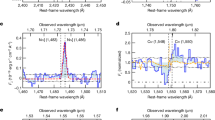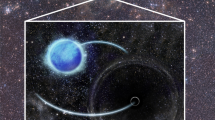Abstract
It is widely accepted that black holes with masses greater than a million solar masses (M ⊙) lurk at the centres of massive galaxies. The origins of such ‘supermassive’ black holes (SMBHs) remain unknown1, although those of stellar-mass black holes are well understood. One possible scenario is that intermediate-mass black holes (IMBHs), which are formed by the runaway coalescence of stars in young compact star clusters2, merge at the centre of a galaxy to form a SMBH3. Although many candidates for IMBHs have been proposed, none is accepted as definitive. Recently, we discovered a peculiar molecular cloud, CO–0.40–0.22, with an extremely broad velocity width, near the centre of our Milky Way galaxy. Based on the careful analysis of gas kinematics, we concluded that a compact object with a mass of about 105 M ⊙ is lurking in this cloud4. Here we report the detection of a point-like continuum source as well as a compact gas clump near the centre of CO–0.40–0.22. This point-like continuum source (CO–0.40–0.22*) has a wide-band spectrum consistent with 1/500 of the Galactic SMBH (Sgr A*) in luminosity. Numerical simulations around a point-like massive object reproduce the kinematics of dense molecular gas well, which suggests that CO–0.40–0.22* is one of the most promising candidates for an intermediate-mass black hole.
This is a preview of subscription content, access via your institution
Access options
Access Nature and 54 other Nature Portfolio journals
Get Nature+, our best-value online-access subscription
$29.99 / 30 days
cancel any time
Subscribe to this journal
Receive 12 digital issues and online access to articles
$119.00 per year
only $9.92 per issue
Buy this article
- Purchase on Springer Link
- Instant access to full article PDF
Prices may be subject to local taxes which are calculated during checkout




Similar content being viewed by others
References
Djorgovski, S. G., Volonteri, M., Springel, V., Bromm, V. & Meylan, G. in The Eleventh Marcel Grossmann Meeting on Recent Developments in Theoretical and Experimental General Relativity, Gravitation and Relativistic Field Theories (eds Kleinert, H., Jantzen R. T. & Ruffini, R.) 340–367 (World Scientific, 2008)
Portegies Zwart, S. F., Makino, J., McMillan, S. L. W. & Hut, P. Star cluster ecology. III. Runaway collisions in young compact star clusters. Astron. Astrophys. 348, 117–126 (1999).
Ebisuzaki, T. et al. Missing link found? The ‘runaway’ path to supermassive black holes. Astrophys. J 562, L19–L22 (2001).
Oka, T., Mizuno, R., Miura, K. & Takekawa, S. Signature of an intermediate-mass black hole in the central molecular zone of our Galaxy. Astrophys. J. 816, L7 (2016).
Oka, T. et al. ASTE CO J = 3–2 survey of the Galactic Center. Astrophys. J. Suppl. 201, 14–25 (2012).
Oka, T., Hasegawa, T., Sato, F., Tsuboi, M. & Miyazaki, A. A large-scale CO survey of the Galactic Center. Astrophys. J. Suppl. 118, 455–515 (1998).
Oka, T. et al. A high-velocity molecular cloud near the center of the Galaxy. Astrophys. J. 515, 249–255 (1999).
Oka, T., Hasegawa, T., Sato, F., Tsuboi, M. & Miyazaki, A. A hyperenergetic CO shell in the Galactic Center molecular cloud complex. Publ. Astron. Soc. Japan 53, 787–791 (2001).
Maillard, J. P., Paumard, T., Stolovy, S. R. & Rigaut, F. The nature of the Galactic Center source IRS 13 revealed by high spatial resolution in the infrared. Astron. Astrophys. 423, 155–167 (2004).
Schödel, R., Eckart, A., Iserlohe, C., Genzel, R. & Ott, T. Black hole in the Galactic Center complex IRS 13E ? Astrophys. J. 625, L111–L114 (2005).
Gillessen, S. et al. Monitoring stellar orbits around the massive black hole in the Galactic Center. Astrophys. J. 692, 1075–1109 (2009).
Pierce-Price, D. et al. A deep submillimeter survey of the Galactic Center. Astrophys. J 545, L121–L125 (2000).
Hatsukade, B. et al. AzTEC/ASTE 1.1-mm survey of the AKARI Deep Field South: source catalogue and number counts. Mon. Not. R. Astron. Soc 411, 102–116 (2011).
Rybicki G. B., & Lightman A. P. Radiative Processes in Astrophysics (Wiley-VCH, Weinheim, Germany, 1986).
Djorgovski, S. & King, I. R. Surface photometry in cores of globular clusters. Astrophys. J. 277, L49–L52 (1984).
McLaughlin, D. E. Binding energy and the fundamental plane of globular clusters. Astrophys. J. 539, 618–640 (2000).
Marchant, A. B. & Shapiro, S. L. Star clusters containing massive, central black holes. III. Evolution calculations. Astrophys. J. 239, 685–704 (1980).
Marconi, A. & Hunt, L. K. The relation between black hole mass, bulge mass, and near-infrared luminosity. Astrophys. J. 589, L21–L24 (2003).
Moran, E. C. et al. Black holes in the centers of nearby dwarf galaxies. Astron. J. 148, 136–157 (2014).
van Loon, J. T. et al. Infrared stellar populations in the central parts of the Milky Way galaxy. Astron. Astrophys. 338, 857–879 (2003).
Sashida, T. et al. Kinematics of shocked molecular gas adjacent to the supernova remnant W44. Astrophys. J. 774, 10–16 (2013).
Yamada, M. et al. Kinematics of ultra-high-velocity gas in the expanding molecular shell adjacent to the W44 supernova remnant. Astrophys. J. 834, L3 (2017).
Takekawa, S., Oka, T., Iwata, Y., Tokuyama, S. & Nomura, M. Discovery of two small high-velocity compact clouds in the central 10 parsecs of the Galaxy. Astrophys. J. 843, L11 (2017).
Agol, E., Kamionkowski, M., Koopmans, Léon, V. E., Blandford & Roger, D. Finding black holes with microlensing. Astrophys. J 576, L131–L135 (2002).
Corral-Santana, J. M. et al. BlackCAT: a catalogue of stellar-mass black holes in X-ray transients. Astron. Astrophys. 587, A61 (2016).
Acknowledgements
This paper makes use of the following ALMA data: ADS/JAO.ALMA#2011.0.01234.S. ALMA is a partnership of ESO (representing its member states), NSF (USA) and NINS (Japan), together with NRC (Canada), MOST and ASIAA (Taiwan), and KASI (Republic of Korea), in cooperation with the Republic of Chile. The Joint ALMA Observatory is operated by ESO, AUI/NRAO and NAOJ. We thank the ALMA staff for the operation of the array and delivering the qualified data. We also thank S. Nakashima and M. Nobukawa for calculating the upper limit to the X-ray flux, and A. E. Higuchi for helping in ALMA data reduction with CASA. T.O. acknowledges support from JSPS Grant-in-Aid for Scientific Research (B) No. 15H03643.
Author information
Authors and Affiliations
Contributions
T.O. directed the research, analysed the data and wrote the manuscript. S.Ts. and M.N. performed the model calculation. Y.I. and S.Ta. contributed to the analyses and discussion.
Corresponding author
Ethics declarations
Competing interests
The authors declare no competing financial interests.
Additional information
Publisher’s note: Springer Nature remains neutral with regard to jurisdictional claims in published maps and institutional affiliations.
Rights and permissions
About this article
Cite this article
Oka, T., Tsujimoto, S., Iwata, Y. et al. Millimetre-wave emission from an intermediate-mass black hole candidate in the Milky Way. Nat Astron 1, 709–712 (2017). https://doi.org/10.1038/s41550-017-0224-z
Received:
Accepted:
Published:
Issue Date:
DOI: https://doi.org/10.1038/s41550-017-0224-z
This article is cited by
-
Astrophysics with the Laser Interferometer Space Antenna
Living Reviews in Relativity (2023)
-
Evidence for an intermediate-mass black hole from a gravitationally lensed gamma-ray burst
Nature Astronomy (2021)
-
Aspects of GRMHD in high-energy astrophysics: geometrically thick disks and tori agglomerates around spinning black holes
General Relativity and Gravitation (2021)
-
A MODEST review
Computational Astrophysics and Cosmology (2018)



